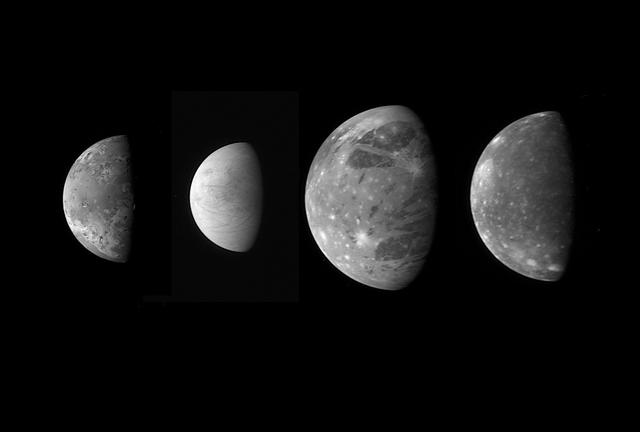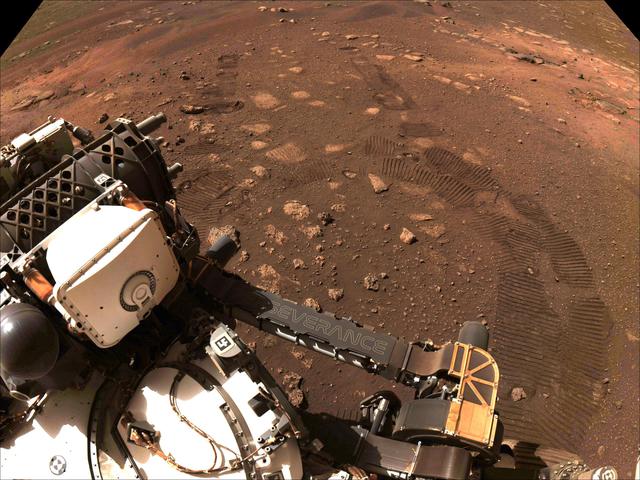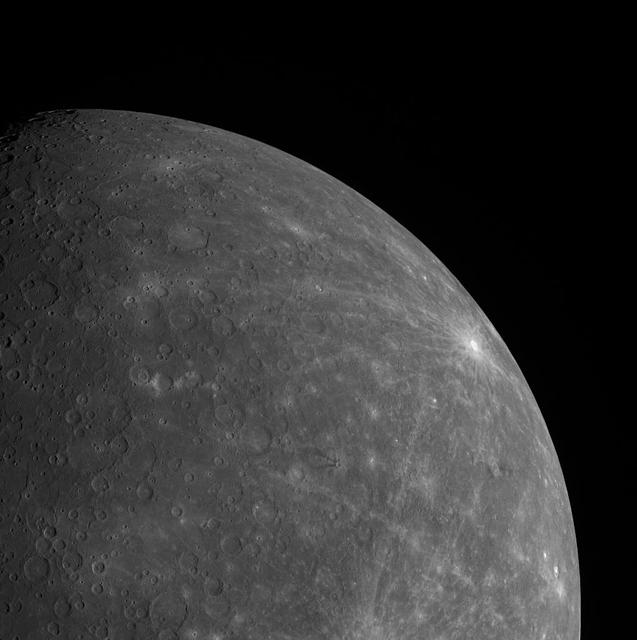
Io, Europa, Ganymede, and Calisto, courtesy of JPL.
Worldbuilding from the bottom up shines when you have a story idea that hinges on one or two setting details. Start with those details and build enough world around them to support your story. Worldbuilding by conflict shines when you want to explore a specific thematic tension or conflict: community versus corporation; family needs versus individual calling; the origin of a rivalry. Worldbuilding by map works well when you want the details of the space to influence the story.
Sometimes, you want to immerse your audience in a self-consistent setting. You want to mention a holiday and know in your heart that it came from this historical moment and was filtered through these perceptions across these three cultures and…
That’s deep worldbuilding. Our advice? Take it slowly.
In deep worldbuilding, your knowledge and experience can shine. If you happen to be a historian in real life, you might find yourself writing a truly evocative series about a Benedictine monk. If you happen to be trained in chemical physics, you might write a hard science fiction series that literally includes quantum mechanical wave functions. Play to your strengths, play to your passions, and be ready to take some time.
Originally, in outlining this article, we intended to look at a scaffolded worldbuilding series, such as Patricia C. Wrede’s “Fantasy Worldbuilding Questions”. We intended to go through a month-long program and report back to you with a condensed summary of our world.
However, something happened to shift our plans: Dungeon23.
According to a gizmodo article, Dungeon23 can be traced back to the creative mind of Sean McCoy. The Internet of Creators grabbed the notion and raced off gleefully. This daily writing practice is fueling dungeons, cities, cultures, and interstellar civilizations. Just today, I’ve encountered entries for a creative fantasy campaign, a space station, the Tower district of a city, the kind of apothecary shop I would enter only with extreme caution, and what looks like the mechanics for an entire table-top role-playing game being built day by day. I love it!
So, in late December, we decided to jump onboard. We agreed that dungeon23, as a long-term practice, was a great opportunity to invest time into one of the settings that we always wanted to build but which would take serious thought and some research to do right.
My partner is a physicist with many ambitions in life, one of which is to end his days as a crotchety asteroid miner. Thus, Sol Prime: a hard or semi-hard science fiction setting based in our own Solar System. Why our solar system? Because there is no point in spending months programming the orbital mechanics of a seven-planet system when Nature has done a nine-planet example for you. Always look in the back of the book. Also, if you have an Internet connection, you have access to a stunning number and variety of glorious images of our Solar system and the bodies that compose it.

Perseverance rover on Mars, image courtesy of NASA/JPL-Caltech
Our goal is to end the year with a setting that is full of rich detail and story hooks, with enough solid science baked in to provide classic hard science fiction dilemmas. As part of the first couple of weeks of dungeon23, we took time to think about how to shape “the rules of the game” to support this goal. Our rules at this point look like this:
- Work on the Sol Prime setting every day. If we have to skip due to illness, emergencies, etc., make it up
- Spend a flexible half-hour a day on it
- Don’t worry about designing a location a day. We have some tough questions to answer. How do people move about? What do they eat and how is it created? What if two stations have different atmospheric constituents? Where do we get the nitrogen for the plants? Some days we can toss off a lighthearted location or piece of a location. Other days, we’re just digging in to the research or spending far too long tinkering with space escalators.
Like NaNoWriMo, dungeon23 is building a community of support. Type “dungeon23” into YouTube or any other social media platform. You’ll see what I mean. There are countless entries, snapshots, and videos by creators who are pursuing the practice, and a separate stack of suggestions for getting started. If, like me, you like the feeling that ‘you are not alone’, dungeon23 is a great space to build your world.
Our Sol Prime setting is driven by practical questions, pre-existing ideas, and sheer desire. For instance, my partner really wanted a traveling diner on Mercury. So, within our deep worldbuilding, we introduced a piece of ‘worldbuilding from the bottom up’. Beginning with the detail of a traveling diner on Mercury, we asked ourselves:
- Who are the patrons of this diner? What are they doing on or near Mercury?
- Who is running the diner? Why are they running it?
- What is powering the diner?
- What happens if the diner breaks down?
and built the world outward from those questions.

The limb of Mercury, taken with Messenger’s Wide-Angle Camera. Image courtesy of JPL, NASA, Johns Hopkins University Applied Physics Laboratory, and the Carnegie Institute of Washington
Mercury is HOT and COLD. Temperatures go from 430 C on the day side to -180 C on the night side. The gravity is two-fifths Earth normal: more than enough to keep the coffee in the cups and the wheels on the ground. Because of the temperature extremes, we agreed this diner really should travel. It rolls along Mercury following the terminus (day-night line). That led to the question, “What surface is it rolling on?” I mean, aside from the complete lack of petroleum products on Mercury, asphalt is definitely a non-starter at 430 C. What survives at those temperatures?
Obviously Mercury does. The geological terranes are the subject of relatively recent study, thanks to data gathered by Messenger. Between the geological data and the new topographical map, we could plot out a practical route around the planet and discuss the surfaces the diner was running over. However, for the purposes of a quick dungeon23 entry, we left this detail as, “The diner moves over a packed regolith bed.” If we need more for a story or to add realism to the setting, we’ll handle it later.
Moving on, the next question was, what is the diner moving with? We left the answer as “large off-roading tires,” obviously imported to Mercury. As to what is powering it, welcome to Mercury, the closest planet to the Sun. Solar power has to be practical in some way around here. We suggested, “some type of beamed power from orbital solar arrays, using foil space mirrors designed to absorb practically nothing; since there is plenty of sunlight around, the mirrors can scatter light without a critical loss in power, so there’s your design slack.”
As to customers, patrons include members of the local orbital science space station, staff of the Mercury mining project (we haven’t written that yet but we have ideas), and members of the Vulcan Plasma Accelerator Facility if it exists. The Vulcan Plasma Accelerator Facility is a place my partner really wants to see come to life in this setting. However, I am keeping a firm veto on the entire idea until my partner can develop it without simultaneously developing a weapon of mass destruction. Then we’ll see.
Who designed, built, and runs the diner? It was designed and built by a corporation that wanted to give science station employees easy access to a change of pace and that has big ideas for developing Mercury as a tourist destination. The diner is a test bed for some of these ideas.
As to the diner itself, it’s called the Sunny-Side-Up diner, famous for its solar-roasted coffee. The chef’s signature dish is a medley of spicy or savory solar-roasted vegetables served with eggs sunny-side-up. There’s a bed-and-breakfast attached behind the diner, which is getting to look more like a set of model train cars every year. Running on a parallel track on the other side of the terminus is the Twilight Cafe. Run by the same company, the Twilight Cafe also includes sleeping accommodation in separate attached cars (with airlock corridors between cars). The Twilight Cafe is famous for their char-broiled near-steak. The signature cocktail is the Solar Sunset. Don’t let anyone serve it to you without the orange ‘prominence’ threads.
We’ve only been working on Sol Prime for twenty-five days, and in that time, we’ve already used top-down, bottom-up, map-based, and conflict-based worldbuilding to construct different areas. Ideas of community versus corporation led to the Oracle, a decentralized interplanetary detection network, and are going to feature more heavily as we zoom in on space station and planetary habitats. Bottom-up worldbuilding is responsible for Fred’s Fuel Farm (a Martian polar facility) and some aspects of the asteroid belt. Top-down worldbuilding is driving the overall picture of where humans are currently living and why. Map-based worldbuildng is responsible for the Big Black Rock Burger Barn on Phobos and the Jupiter base-jumping platform. As we continue with this exercise in deep worldbuilding, we expect to pick up new tools and new ideas, and we hope to continue sharing them with you.
Next time, we’ll talk about more structured approaches to deep worldbuilding. In the meantime, check out dungeon23, and maybe, jump in.
0 Comments